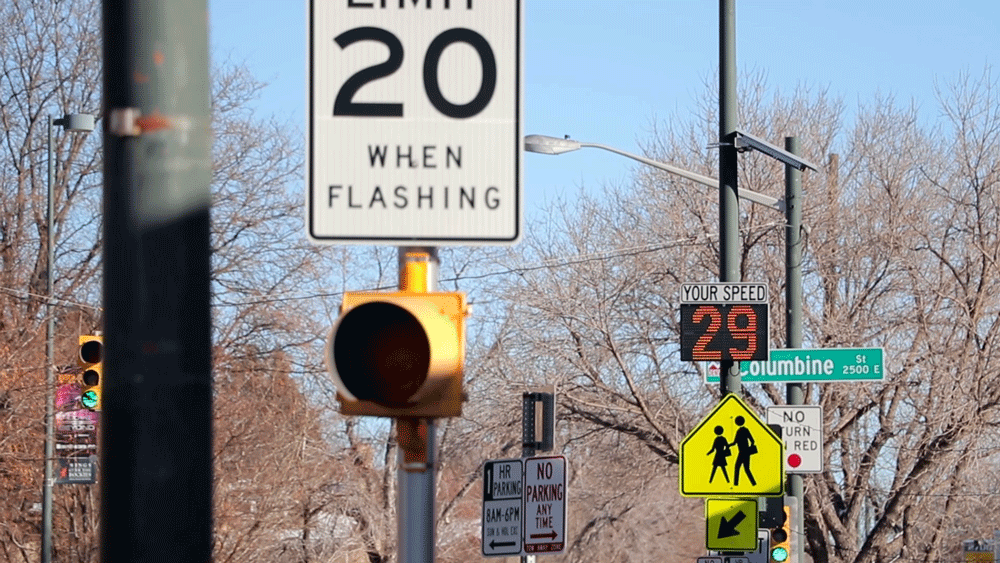Better slow down when you hit your local streets.
Denver City Council approved the "20 is plenty" ordinance, which will reduce the speed limit on neighborhood streets from 25 to 20 MPH. The council voted 11-1 on Monday, with Councilmember Kendra Black voting against it.
The bill was spearheaded by Councilmember Paul Kashmann, who previously said residents in his district were constantly complaining about drivers moving too fast down local streets even though police studies showed that on average, drivers weren't straying far from the previous 25 MPH limit.
Kashmann said residents weren't "comfortable with the existing speed limit" because "it feels too fast for them."
"People would tell us that [drivers] are going 50 MPH but they're not," Kashmann said. "They're driving 25, 28, 32 MPH. So, the 25 MPH speed limit is uncomfortable for a lot of people."
The change does not affect major arteries and will only occur on residential streets. For a visual reference, those are streets with no stripes or centerlines. Speed limits in Denver parks will also officially be changed from 20 mph to 15 mph, a policy already in place through the Parks and Recreation department.
As part of the bill, speed limit signs would be changed and relocated.

Department of Transportation and Infrastructure Spokesperson Vanessa Lacayo said there are currently about 2,700-3,500 25-mph speed limit signs on local streets. It'll take around three to five years to implement the signage changes.
"We want to complete the work as soon as possible after the change to avoid confusion regarding speed limits on local streets, but it will take a little time to implement," Lacayo said. "We plan to reduce the overall number of signs out now down to approximately 1,000 signs with a focus on areas that enter onto the local streets off of the arterial streets. We will also use what we call gateway signs - so, as people enter Denver off the highways, we will have informational signs that state the speed limit on local roads is 20 mph."
Lacayo said the changes will cost approximately $1.2 million and $1.5 million and that "will be covered partly by next year's parking meter rate increase and the city's capital improvement program."
Black voted no on the bill due to the high cost of the signage change. She argued that funding should go toward Denver's arterial streets.
"According to DOTI's own data, our most dangerous streets by far for pedestrians and cyclist are our arterial streets, which make up 16% of our streets but account for 80% of pedestrian fatalities," Black said. "While I do support lowering speed limits, I am not supporting this bill simply because it will take precious dollars away from our Vision Zero budget...DOTI funds should be prioritized to address issues on our arterials, on our high injury network streets like Federal, Colorado Boulevard and Hampden."
Other councilmembers, including Councilmember At-large Debbie Ortega, agreed with Black's assessment of arterial streets but noted that changing the speed limit on local roads was also needed.
Kashman's proposal came after a study examined the feasibility of lowering the speeds on each of Denver's four types of streets, including neighborhood streets, arterials and collectors, school zones, and areas deemed "slow zones." The $350,000 study determined that the "primary tool" to increase safety on neighborhood streets "would be a change in speed limit signs and a sign placement policy."

The proposal also stems from Vision Zero, the city's initiative to completely eradicate traffic deaths and serious injuries by 2030. Since Denver joined the international safe-streets program in 2016, 386 people have died in traffic incidents.
As of December 20, 82 people have died in traffic crashes this year, surpassing Denver's record high of 71 people, set in 2019. The only month the city has ever gone without recorded traffic fatalities was April 2020, the height of the state's stay at home orders.
According to the Department of Transportation and Infrastructure, 7% of serious injuries happen on neighborhood streets that don't have painted lanes.
"We hope reducing the speed limit on our local streets will address resident concerns," Lacayo said. "We also think the initiative could draw attention to the topic of speed in general - get people thinking about it and about driving the speed limit. While we know most fatal and serious injury crashes are happening on our arterial and collector streets as opposed to the local streets, we think this is a good first step."













